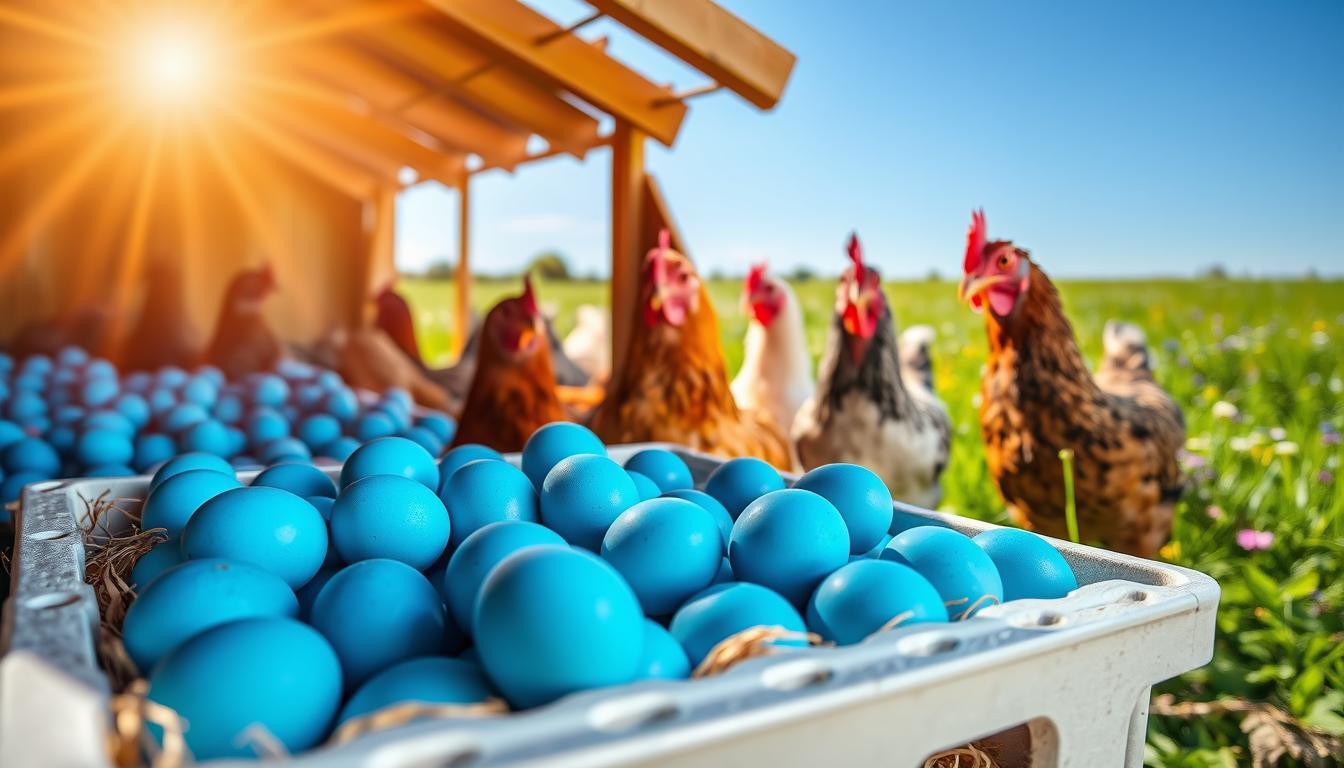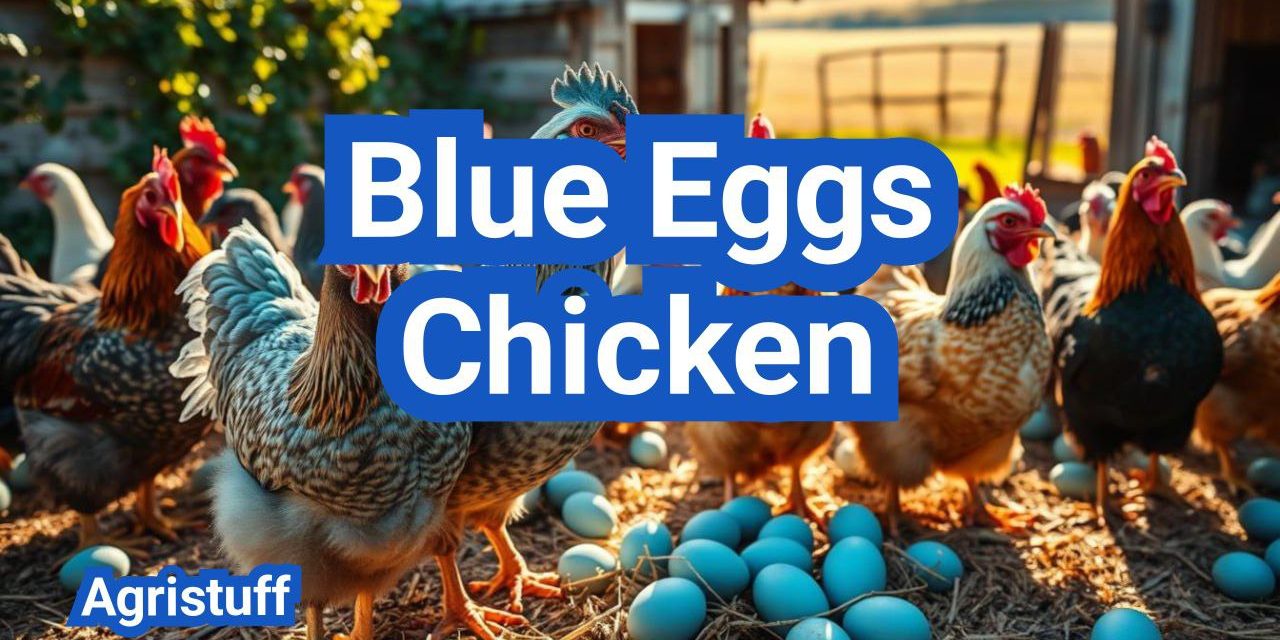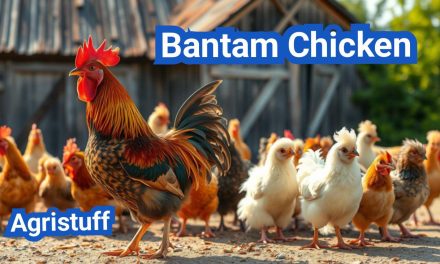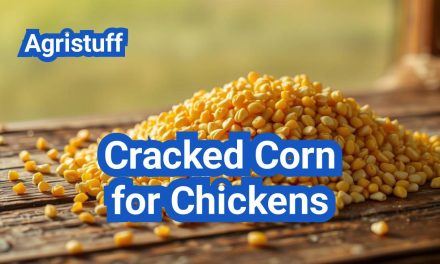The world of backyard chickens is full of surprises, and one of the most fascinating is the presence of breeds that lay blue eggs. But what makes these eggs blue, and are they nutritionally different from their white or brown counterparts?
The pigment responsible for the blue color is oocyanin, which permeates the eggshell. Breeds like the Araucana and Ameraucana are known for laying these unique eggs.
The nutritional value of these blue eggs is similar to that of other eggs, with the color having no impact on their health benefits. This makes them a delightful addition to any egg collection, offering both a unique appearance and a rich source of nutrition.
Key Takeaways
- Blue eggs owe their color to the pigment oocyanin.
- Breeds like Araucana and Ameraucana lay blue eggs.
- The nutritional value of blue eggs is similar to other eggs.
- Blue eggs are a unique and nutritious addition to any egg collection.
- The color of the eggs does not affect their nutritional value.
The Science Behind Blue Eggs Chicken
Blue eggs, a hallmark of certain chicken breeds, owe their distinctive color to a complex interplay of genetics and pigmentation. The unique characteristic of laying blue eggs is not just aesthetically pleasing but also rooted in fascinating biological processes.
What Makes Eggshells Blue?
The blue coloration of eggshells is primarily due to the presence of a pigment called oocyanin, which is derived from bile. This pigment is deposited onto the eggshell during its formation in the hen’s oviduct. Unlike other eggshell pigments that may be influenced by diet or environmental factors, the blue color is genetically determined.
The process of eggshell formation is intricate, involving various stages where different pigments can be deposited. In the case of blue eggs, the oocyanin pigment is responsible for the blue hue. This is distinct from the process that creates brown or pink eggshells, which involve different pigments and genetic mechanisms.
The Oocyan Gene and Biliverdin Pigmentation
The oocyan gene plays a crucial role in the production of blue eggs. This gene influences the deposition of oocyanin, resulting in the blue color. Additionally, biliverdin, another pigment derived from bile, can also contribute to the coloration, sometimes producing green or other shades when combined with the blue pigment.
The interaction between genetics and pigmentation is complex. While the oocyan gene is key to blue eggshell color, other genetic and environmental factors can influence the intensity and shade of the blue. Understanding these factors can help breeders and backyard chicken keepers appreciate the uniqueness of their blue egg-laying hens.
By grasping the science behind blue eggs, enthusiasts can better understand the biology and genetics that make these eggs so unique. This knowledge not only enhances appreciation for these special breeds but also informs breeding practices and care for these remarkable chickens.
Top Blue Egg Laying Chicken Breeds

For those looking to add some color to their egg basket, several chicken breeds are renowned for laying blue eggs. These breeds not only offer a unique egg-laying capability but also bring diverse characteristics to a flock.
Araucana: The Original Blue Egg Layer
The Araucana breed is one of the most well-known for laying blue eggs. Originating from Chile, this breed is not only prized for its egg color but also for its unique appearance, which includes ear tufts and a lack of tail feathers. Araucanas are known for their friendly disposition, making them a great addition to many backyard flocks.
Araucanas lay a moderate number of eggs, with the blue color ranging from sky blue to a deeper blue hue. Their eggshell color is due to the oocyan gene, which is a result of biliverdin pigmentation.
Ameraucana: The American Blue Egg Champion
Developed in the United States, the Ameraucana breed is another popular choice for those seeking blue eggs. Ameraucanas are known for their ability to lay a consistent number of eggs, and their eggs are often described as having a light blue to blue-green color. They are also recognized for their muffs and beards, giving them a distinctive look.
Ameraucanas are generally considered to be friendly and docile, making them suitable for families. They are also known for their hardiness and adaptability to various climates.
Easter Egger: Colorful Surprise in Every Clutch
Easter Eggers are a cross between a breed that carries the blue egg gene (like Araucana or Ameraucana) and another breed, often resulting in a variety of egg colors, including blue, green, and pink. Easter Eggers are known for their high egg production and are often kept for their ability to lay a colorful assortment of eggs.
These chickens are generally friendly and can be quite curious. Their egg-laying capability and the variety of egg colors make them a popular choice among backyard chicken enthusiasts.
Cream Legbar: The Auto-Sexing Blue Egg Layer
The Cream Legbar is a breed that not only lays blue or green eggs but is also auto-sexing, meaning chicks can be sexed at hatch based on their feather color. This breed is known for its high egg production and friendly nature.
Cream Legbars are relatively low maintenance and are known for their ability to forage. They are a great choice for those looking for a breed that is both productive and easy to care for.
Each of these breeds offers unique characteristics and advantages, making them suitable for different needs and preferences. Whether you’re looking for high egg production, unique egg colors, or friendly dispositions, there’s a blue egg-laying breed that’s right for you.
Lesser-Known Blue Egg Layers Worth Considering
While many are familiar with mainstream blue egg layers, several lesser-known breeds offer unique characteristics and advantages that can enhance any backyard flock.
Prairie Bluebell Egger Chickens
The Prairie Bluebell Egger is a breed known for its consistent production of blue eggs. They are a cross between a Barred Rock and an Araucana or Ameraucana, inheriting the blue egg-laying trait. These chickens are not only prolific layers but also known for their friendly disposition.
Whiting True Blue
Whiting True Blue chickens are another breed that lays blue eggs consistently. They are known for their high production rate and are often praised for their robust health and friendly nature, making them an excellent choice for families.
Arkansas Blue and Silverudd’s Blue
The Arkansas Blue is a hardy breed that produces a large number of eggs. They are known for their foraging ability and robust health. Silverudd’s Blue is another lesser-known breed that lays blue eggs and is recognized for its unique genetic background and egg-laying consistency.
Blue Laced Red Wyandotte | Blue Eggs Chicken
Although not all Blue Laced Red Wyandotte hens lay blue eggs, some individuals within this breed can produce a blue or green tinted egg. They are known for their beautiful plumage and friendly temperament, making them a popular choice among backyard chicken keepers.
| Breed | Egg Color | Production Rate | Temperament |
|---|---|---|---|
| Prairie Bluebell Egger | Blue | High | Friendly |
| Whiting True Blue | Blue | High | Friendly |
| Arkansas Blue | Blue | High | Hardy |
| Silverudd’s Blue | Blue | Consistent | Robust |
| Blue Laced Red Wyandotte | Blue/Green Tinted | Variable | Friendly |
These lesser-known breeds offer a range of benefits, from high egg production to unique genetic traits, making them worth considering for anyone looking to expand their flock with blue egg layers.
How to Choose the Right Blue Egg Layer for Your Flock

With numerous blue egg-laying breeds available, choosing the right one for your flock requires careful consideration of several key factors. Whether you’re a seasoned backyard chicken keeper or just starting out, understanding the characteristics of different breeds can help you make an informed decision.
Climate Considerations and Hardiness | Blue Eggs Chicken
When selecting a blue egg layer, it’s crucial to consider the climate in your area and the hardiness of the breed. Some breeds are more tolerant of extreme temperatures than others. For instance, Araucana and Ameraucana chickens are known for their ability to adapt to various climates, making them suitable for a wide range of environments.
On the other hand, breeds like the Cream Legbar may require more specific care in colder climates. Ensuring that your chosen breed can thrive in your local climate is essential for their health and productivity.
Space Requirements and Temperament | Blue Eggs Chicken
The amount of space you have available for your chickens and their temperament are also critical factors. Breeds like the Prairie Bluebell Egger are known for their friendly nature and can do well in smaller spaces if provided with adequate exercise and enrichment.
Conversely, more active breeds may require larger areas to roam. Understanding the space requirements and temperament of your chosen breed will help ensure a harmonious and productive flock.
Production Rates and Egg Size | Blue Eggs Chicken
Egg production rates and sizes can vary significantly between breeds. If you’re looking for a consistent supply of blue eggs, breeds like the Ameraucana are known for their reliable production. However, if you’re interested in a variety of egg colors, Easter Eggers might be a better choice, as they can produce eggs in shades ranging from blue to green and pink.
Considering your needs and preferences regarding egg production will help narrow down the best breed for your flock.
Pure Breeds vs. Hybrid Layers | Blue Eggs Chicken
Another important consideration is whether to choose pure breeds or hybrid layers. Pure breeds, such as the Araucana, offer the advantage of breed consistency and the potential for breeding your own flock. However, they may come with specific challenges, such as genetic issues associated with certain breed characteristics.
Hybrid layers, like Easter Eggers, often benefit from hybrid vigor, which can result in higher egg production rates and hardiness. Deciding between pure breeds and hybrids depends on your goals, whether you’re focused on egg production, breed preservation, or a combination of both.
By carefully evaluating these factors, you can select the right blue egg layer for your flock, ensuring a rewarding experience and a bountiful supply of beautiful blue eggs.
Setting Up Your Coop for Blue Egg Layers
A well-designed coop is essential for the well-being of your blue egg-laying chickens and the quality of the eggs they produce. When setting up your coop, several key factors must be considered to ensure the health and productivity of your flock.
Space Requirements and Ventilation | Blue Eggs Chicken
Providing adequate space is crucial for the health of your chickens. The coop should offer at least 3-4 square feet per chicken inside, with enough room outside for them to roam. Proper ventilation is also vital to remove moisture and ammonia from the coop, reducing the risk of respiratory issues. Installing windows or vents that can be opened and closed as needed can help achieve good airflow.
Nesting Box Design for Egg Protection | Blue Eggs Chicken
Nesting boxes should be designed to protect the eggs from breakage and the hens from stress. One box per 3-4 hens is a good rule of thumb. The boxes should be lined with soft bedding like straw or pine shavings and placed in a quiet, dark area of the coop to encourage hens to lay eggs there. Consider using boxes with roofs or dividers to reduce egg breakage and hen pecking.
Predator-Proofing Your Coop | Blue Eggs Chicken
Predator-proofing is a critical aspect of coop design. Use strong materials like hardware cloth instead of chicken wire, as it’s more difficult for predators to tear. Ensure all windows and vents are covered with this material, and that the coop is securely locked at night. Regularly inspect the coop for any weaknesses or damage.
Roosting Arrangements | Blue Eggs Chicken
Roosting bars should be sturdy and placed higher than the nesting boxes to encourage hens to roost at night. The bars should be wide enough for the hens to comfortably grasp them, typically around 2-3 inches wide. Ensure there’s enough roosting space for all hens, as overcrowding can lead to stress and health issues.
Feeding Blue Eggs Chicken for Optimal Production

Feeding blue egg layers the right nutrients is essential for supporting their health and maximizing egg production. A balanced diet is crucial for maintaining the overall well-being of these chickens and ensuring they produce high-quality, vibrant blue eggs.
Essential Nutrients for Vibrant Blue Eggs
Blue egg-laying hens require a diet rich in essential nutrients, including proteins, vitamins, and minerals. Proteins are vital for overall health, while vitamins and minerals play a crucial role in eggshell production and coloration. A well-balanced layer feed typically contains the necessary nutrients, but supplements can be added to enhance egg production and quality.
Calcium Supplementation for Strong Shells | Blue Eggs Chicken
Calcium is a critical component for strong eggshells. Insufficient calcium can lead to weak or thin shells, which can be detrimental to egg production. Providing crushed oyster shells or dark leafy greens like kale can help supplement the hens’ diet with calcium, ensuring robust and healthy eggshells.
Seasonal Feeding Adjustments | Blue Eggs Chicken
Seasonal changes can impact egg production, and adjusting the diet accordingly can help maintain optimal production levels. During colder months, increasing the energy content of their feed can help keep hens warm and support continuous egg laying. Conversely, in hotter months, ensuring adequate hydration and providing cooling treats can help reduce stress.
Treats and Supplements That Enhance Egg Color
Certain treats and supplements can enhance the color and nutritional value of blue eggs. For instance, marigold petals can intensify the yolk color, while flaxseed can enrich the eggs with omega-3 fatty acids. It’s essential to introduce these supplements in moderation to avoid disrupting the balance of the hens’ diet.
Ameraucana vs. Easter Egger: Understanding the Difference

Both Ameraucanas and Easter Eggers are known for their ability to lay blue eggs, but they have distinct differences. Understanding these differences is crucial for backyard chicken enthusiasts looking to add these breeds to their flock.
Breed Standards and Recognition | Blue Eggs Chicken
The Ameraucana is a recognized breed by the American Poultry Association (APA), known for its distinctive appearance and blue egg-laying ability. “Ameraucanas are bred to a specific standard, which includes characteristics such as muffs, beards, and a pea comb,” notes a poultry expert. In contrast, Easter Eggers are not a recognized breed but rather a hybrid or mixed breed that can lay a variety of egg colors, including blue, green, and pink.
Breed Recognition: Ameraucanas are recognized by the APA, while Easter Eggers are not.
- Ameraucanas have a specific breed standard.
- Easter Eggers are known for their varied egg colors.
Egg Color Consistency and Production Rates
When it comes to egg color consistency, Ameraucanas are known for laying a consistent blue or blue-green egg. Easter Eggers, on the other hand, can lay a variety of egg colors, and the color can vary from hen to hen.
Egg Production: Ameraucanas tend to lay around 200 eggs per year, while Easter Eggers can lay a similar number, but the color variety is a significant distinguishing factor.
As Tom Smith, a seasoned poultry breeder, once said, “The beauty of Easter Eggers lies in their unpredictability, while Ameraucanas offer consistency in their blue eggs.” This quote highlights the fundamental difference between the two breeds.
Health Management for Blue Egg Layers

To keep your blue egg layers healthy and productive, it’s essential to implement a comprehensive health management plan. Effective health management involves regular monitoring, preventative care, and awareness of genetic concerns specific to certain breeds.
Common Health Issues in Blue Egg Breeds
Blue egg layers can be susceptible to various health issues, including respiratory problems, parasites, and reproductive tract issues. Regular health checks can help identify these problems early on.
- Respiratory infections can be caused by poor ventilation in the coop.
- External parasites like mites and lice can cause discomfort and anemia.
- Reproductive issues can arise from egg binding or egg yolk peritonitis.
Preventative Care Schedule | Blue Eggs Chicken
A preventative care schedule is crucial for maintaining the health of your blue egg layers. This includes regular vaccinations, parasite control measures, and health checks.
- Regularly inspect your flock for signs of illness or stress.
- Implement a parasite control program to prevent infestations.
- Ensure your coop is well-ventilated to prevent respiratory issues.
Genetic Concerns (Ear Tufts in Araucanas) | Blue Eggs Chicken
Araucanas, known for their ear tufts, can be prone to genetic issues related to this trait. The gene responsible for ear tufts can also be linked to other health concerns.
It’s crucial to be aware of these genetic concerns when breeding Araucanas.
When to Consult a Veterinarian | Blue Eggs Chicken
Knowing when to consult a veterinarian is vital for addressing health issues promptly. If you notice any unusual behavior, signs of illness, or a decline in egg production, seek professional advice.
Regular health checks and preventative care can significantly improve the health and productivity of your blue egg layers.
Maximizing Blue Egg Production

The key to maximizing blue egg production lies in creating an optimal environment for your hens. This involves a combination of proper management techniques and a deep understanding of the factors that influence egg laying.
Lighting Requirements Throughout Seasons
Lighting plays a crucial role in egg production. Hens require a certain amount of daylight to maintain their laying cycle. During the shorter days of winter, supplemental lighting can be used to extend the daylight period, ensuring consistent egg production. It’s essential to gradually introduce additional lighting to avoid stressing the hens.
Tips for Implementing Supplemental Lighting:
- Use LED lights, which are energy-efficient and produce less heat.
- Install lights in a way that they are not directly visible to the hens to avoid causing stress.
- Gradually increase the lighting period to simulate natural daylight extension.
Stress Reduction Techniques | Blue Eggs Chicken
Stress is a significant factor that can negatively impact egg production. Reducing stress in your flock can be achieved through several methods, including providing adequate space, ensuring access to clean water and nutritious feed, and minimizing disturbances.
Creating a Stress-Free Environment:
- Ensure enough space per hen inside the coop to prevent overcrowding.
- Maintain cleanliness and provide fresh water and feed daily.
- Minimize loud noises and sudden movements near the coop.
Molting Management | Blue Eggs Chicken
Molting is a natural process for hens, during which they shed and regrow their feathers. This period can significantly reduce egg production. Managing molting effectively involves providing a nutrient-rich diet that supports feather regrowth and overall health.
Nutritional Support During Molting:
- Increase protein intake to support feather regrowth.
- Provide a balanced diet that includes essential vitamins and minerals.
- Ensure access to clean water at all times.
Flock Rotation Strategies | Blue Eggs Chicken
Rotating your flock can help maintain egg production by ensuring that you have a consistent number of laying hens. This involves introducing new hens to the flock while phasing out older or less productive hens.
Benefits of Flock Rotation:
- Maintains consistent egg production levels.
- Reduces the risk of disease by introducing new genetics.
- Allows for the removal of non-productive or unhealthy hens.
Blue Eggs Chicken Lifespan and Long-Term Care

Understanding the lifespan of your blue egg layers is crucial for providing the best long-term care. Blue egg-laying chickens, like other breeds, have varying lifespans based on factors such as genetics, nutrition, and management practices.
Average Productive Years | Blue Eggs Chicken
The average productive lifespan of blue egg layers ranges from 5 to 7 years, depending on the breed and individual health. Araucana and Ameraucana breeds are known for their longevity, with some hens continuing to lay eggs well into their 6th year.
Supporting Aging Hens | Blue Eggs Chicken
As hens age, their nutritional needs change. Providing a balanced diet that includes calcium supplementation is crucial for maintaining strong eggshell production. Regular health checks can help identify any issues early.
- Monitor egg production and adjust nutrition accordingly
- Provide a safe and comfortable living environment
- Ensure access to fresh water and a balanced diet
When Production Declines | Blue Eggs Chicken
As blue egg layers age, their egg production will naturally decline. This decline can be influenced by factors such as nutrition, health, and stress levels. Adjusting their diet and ensuring they have a stress-free environment can help maintain production for as long as possible.
Retirement Planning for Your Flock | Blue Eggs Chicken
Planning for the retirement of your blue egg layers involves considering their welfare and the potential for rehoming or providing a safe retirement on your farm. Many backyard chicken keepers choose to keep their hens in a separate “retirement” area where they can live out their lives without the stress of egg production.
By understanding the lifespan and needs of your blue egg layers, you can provide the best possible care throughout their lives, ensuring they remain healthy and productive for as long as possible.
Blue Eggs vs. Regular Eggs: What to Expect

While regular eggs are a staple in many kitchens, blue eggs offer a fascinating alternative with several key differences. Whether you’re a seasoned poultry keeper or just starting out, understanding these differences can help you appreciate the unique qualities of blue eggs.
Taste Comparison and Culinary Uses | Blue Eggs Chicken
One of the most common questions about blue eggs is whether they taste different from regular eggs. The good news for culinary enthusiasts is that the taste of blue eggs is virtually indistinguishable from that of regular eggs. The unique blue color is purely a cosmetic difference, resulting from the genetics of the chicken breed rather than any difference in the egg’s composition.
In culinary applications, blue eggs can be used in exactly the same ways as regular eggs. They make a beautiful addition to baked goods, salads, and breakfast dishes. Some chefs and bakers even report that the novelty of using blue eggs can add an extra layer of creativity to their recipes.
Nutritional Profile of Blue Eggs
Nutritionally, blue eggs are on par with regular eggs. They contain the same amount of protein, vitamins, and minerals as their more conventional counterparts. The nutritional profile of an egg is determined by the chicken’s diet and breed, not by the eggshell color.
- Protein content remains consistent across egg types.
- Vitamin and mineral levels are similar in blue and regular eggs.
- The cholesterol content is also comparable.
Shell Strength and Storage Considerations | Blue Eggs Chicken
Some studies suggest that blue eggs may have slightly thicker shells than regular eggs, potentially due to the genetic factors that influence eggshell color. However, this can vary depending on the breed and individual chicken.
Storage considerations for blue eggs are the same as for regular eggs. Proper refrigeration and handling will keep blue eggs fresh for just as long as regular eggs.
Marketing Your Blue Eggs
The unique color of blue eggs can be a significant marketing advantage, especially at farmers’ markets or for direct sales to consumers. Here are some strategies to consider:
- Highlight the novelty: Use the unique color as a selling point, emphasizing the natural and often heritage breed origins.
- Emphasize quality: Pair the unique appearance with assurances of high-quality production methods.
- Target specialty markets: Consider selling to high-end restaurants or bakeries looking for unique ingredients.
By understanding the differences and similarities between blue eggs and regular eggs, producers and consumers alike can appreciate the unique value that blue eggs bring to the table.
Creating Olive Eggers: Breeding Blue with Brown

Breeding blue egg layers with brown egg layers can result in Olive Eggers, a unique and fascinating outcome for backyard chicken enthusiasts. This process involves understanding the genetics behind the eggshell colors and carefully selecting the parent stock.
Step-by-Step Breeding Guide | Blue Eggs Chicken
To create Olive Eggers, start by selecting a blue egg-laying breed, such as an Ameraucana or Araucana, and a brown egg-laying breed. The blue egg gene and the brown egg gene combine to produce an olive green color in the offspring’s eggs. It’s crucial to understand that the genetics of eggshell color is complex and involves multiple genes.
The first step is to choose healthy, genetically diverse birds to ensure the vitality of the offspring. When breeding, consider the temperament and hardiness of the parent breeds to produce robust Olive Eggers.
Selecting Parent Stock | Blue Eggs Chicken
When selecting parent stock, look for breeds that are known for their egg-laying abilities and hardiness. For blue egg layers, breeds like Ameraucana and Araucana are popular choices. For brown egg layers, consider breeds like Marans or Barnevelder. The key is to select breeds that complement each other in terms of temperament and production traits.
Predicting Egg Colors in Offspring | Blue Eggs Chicken
Predicting the egg color of Olive Eggers involves understanding the genetics of the parent breeds. The interaction between the blue and brown pigments determines the olive color. While it’s challenging to predict the exact shade, breeders can anticipate a range of olive tones. Keeping detailed records of the breeding process and the resulting egg colors can help refine future breeding decisions.
Popular Olive Egger Combinations | Blue Eggs Chicken
Some popular combinations for creating Olive Eggers include pairing Ameraucana with Marans or Araucana with Barnevelder. These combinations often result in a beautiful range of olive green eggs.
Experimenting with different breed combinations can lead to unique and varied egg colors, making the breeding process both challenging and rewarding.
Where to Purchase Blue Egg Layers
Adding blue egg layers to your backyard flock starts with sourcing them from reliable suppliers. Whether you’re a seasoned poultry keeper or a beginner, finding the right breeders or hatcheries is crucial for obtaining healthy, high-quality birds.
Reputable Hatcheries in the USA | Blue Eggs Chicken
The United States is home to numerous reputable hatcheries that specialize in blue egg-laying breeds. Some of the top hatcheries include:
- Meyer Hatchery
- Welp Hatchery
- Metzer Farms
- Hoffmann Hatchery
These hatcheries offer a range of blue egg layers, from Araucanas to Ameraucanas and Easter Eggers. When selecting a hatchery, consider factors such as breed variety, shipping policies, and customer reviews.
Finding Blue Egg Chickens in the UK and Australia | Blue Eggs Chicken
For those outside the USA, there are also excellent sources for blue egg layers in other countries. In the UK, breeders often sell through poultry clubs or online marketplaces. Some notable UK breeders include:
- The Poultry Club of Great Britain
- UK Poultry Breeders
In Australia, you can find blue egg layers through:
- The Australian Poultry Society
- Australian Chicken Breeders
When purchasing internationally, be sure to research import regulations and quarantine requirements.
What to Look for When Buying Chicks | Blue Eggs Chicken
When buying chicks, look for signs of health and vitality. Healthy chicks are active, have bright eyes, and are free from visible defects. Consider the following:
- Reputation of the breeder or hatchery
- Vaccination policies
- Shipping practices
- Guarantees or replacement policies
Costs and Investment Considerations | Blue Eggs Chicken
The cost of blue egg layers can vary significantly based on breed, age, and location. On average, you can expect to pay between $3 to $10 per chick, with purebred birds typically costing more than hybrids. Additional costs include:
- Coop setup and equipment
- Feed and supplements
- Veterinary care
When calculating the total investment, consider both the initial costs and ongoing expenses to ensure that your backyard flock remains healthy and productive.
Enjoying the Beauty and Bounty of Blue Eggs
Blue egg-laying chickens bring a unique and colorful element to any backyard flock, enhancing the overall chicken-keeping experience. The beauty of blue eggs lies not only in their striking color but also in the joy they bring to those who collect them.
Enjoying blue eggs is a delight for many backyard chicken keepers. Whether you’re a seasoned enthusiast or just starting out, the charm of blue egg layers is undeniable. From the Araucana to the Easter Egger, these breeds offer a fascinating glimpse into the world of colored egg production.
For those looking to add some excitement to their egg collection, blue egg layers are an excellent choice. With proper care and management, these chickens can provide a bountiful supply of blue eggs, each one a testament to the beauty and diversity of nature.
As you explore the world of blue egg layers, you’ll discover the many benefits they bring to your flock. Not only do they provide a unique egg-laying experience, but they also add a touch of personality and charm to your backyard.
FAQ
What makes chickens lay blue eggs?
The oocyan gene and biliverdin pigmentation are responsible for blue eggshells. This unique genetic trait is found in specific breeds like Ameraucanas and Araucanas.
Are blue chicken eggs healthier than regular eggs?
The nutritional value of blue eggs is similar to that of regular eggs. The color of the eggshell does not affect the egg’s health benefits.
Do blue chicken eggs taste different?
The taste of blue eggs is similar to that of regular eggs. The eggshell color does not impact the flavor or texture of the egg.
What are the most popular blue egg-laying chicken breeds?
Some of the most popular blue egg-laying breeds include Ameraucanas, Araucanas, Easter Eggers, and Cream Legbars.
How do I choose the right blue egg layer for my flock?
Consider factors like climate, space, temperament, and egg production when selecting a blue egg-laying breed.
What are the nutritional requirements of blue egg-laying hens?
Blue egg-laying hens require a balanced diet that includes essential nutrients like calcium, protein, and vitamins to support optimal egg production.
How can I maximize blue egg production?
Strategies like providing adequate lighting, reducing stress, and managing molting can help maximize blue egg production.
What is the average lifespan of blue egg-laying hens?
The average lifespan of blue egg-laying hens varies by breed, but most hens can live between 5-10 years.
Can I breed blue egg-laying chickens to create Olive Eggers?
Yes, breeding blue egg-laying chickens with brown egg-laying breeds can create Olive Eggers, which produce olive-green eggs.
Where can I purchase blue egg-laying chickens?
Reputable hatcheries and breeders in the USA, UK, and Australia sell blue egg-laying chickens. Research and choose a trustworthy supplier.
Are blue eggs more expensive than regular eggs?
Blue eggs can be more expensive due to the unique genetics and breeding required to produce them.
How do I care for aging blue egg-laying hens?
Provide a comfortable and safe environment, adjust their diet, and monitor their health to support aging hens.
Conclusion of: Blue Eggs Chicken Breeds
Blue Eggs Chicken breeds delight backyard keepers and small farms across the U.S. with shells that range from sky blue to teal and olive. Beyond the beauty, these colored eggs come from specific genetics found in a handful of breeds and hybrids, each with its own temperament, productivity, and care needs. This guide explains how Blue Eggs Chicken genetics work, which breeds reliably lay them, how nutrition and management affect shell quality, and how to choose the right layers for your flock.
Why chicken eggs come in different colors — Michigan State University Extension. AgriNatural College
What Makes a Blue Eggs Chicken Lay Blue?
At the heart of the Blue Eggs Chicken phenomenon is a genetic “switch”: an insertion from an ancient endogenous retrovirus near the SLCO1B3 gene in the shell gland (uterus) that drives deposition of a blue pigment throughout the shell. That’s why the inside of a blue shell is blue, too. This oocyan (O) trait is autosomal dominant, so one copy is usually enough for blue eggs.
Genetic mechanism for blue eggs in chickens — PLOS Genetics. PLOS
The Pigment Story Behind Blue Eggs Chicken Shells
Blue Eggs Chicken shells get their color primarily from biliverdin (and its zinc chelates), a bile pigment produced via heme breakdown; brown shells rely on protoporphyrin-IX. Blue pigment permeates the shell matrix, whereas brown pigments mostly coat the exterior. Understanding this chemistry explains why crossing blue-shell layers with brown-shell layers yields green or olive eggs.
Eggshell pigments overview — Poultry Science (open access, 2024). PMC
Are Blue Eggs Chicken Eggs More Nutritious?
No—shell color doesn’t change nutritional content. Nutrient density is influenced by the hen’s diet, housing, and overall management, not by brown, white, or Blue Eggs Chicken shell color. Choose quality feed and good husbandry rather than a shell color if nutrition is your goal.
Eggshell color vs. nutrition — UF/IFAS Extension. What’s Happening Around Florida
Egg Quality & Handling for Blue Eggs Chicken Flocks
The same practices that improve any egg will help Blue Eggs Chicken eggs: balanced layer rations, free-choice calcium (oyster shell/limestone), clean nest boxes, and prompt cooling/clean handling. Age and health also influence shell strength and appearance.
Proper egg quality & handling — Penn State Extension. Penn State Extension
How Green and Olive Appear from Blue Eggs Chicken Lines
When a Blue Eggs Chicken (blue-shell base) is crossed with a brown-egg breed that applies a protoporphyrin coating, the result is green to olive eggs. The base-shell blue plus the brown overlay produces those coveted “olive” tones seen in Olive Eggers and some Easter Eggers.
Why egg colors vary & how blending works — MSU Extension. AgriNatural College
Araucana: The Original Blue Eggs Chicken
Araucanas trace to Chile (Mapuche heritage). In U.S. standards they’re rumpless and often tufted; the ear-tuft gene is tied to reduced hatchability when homozygous, which makes consistent breeding challenging. For flocks wanting authentic heritage and the bluest shells, the Araucana is iconic—though harder to source and breed well.
Araucana breed profile — The Livestock Conservancy. The Livestock Conservancy
The Ear-Tuft Gene in Blue Eggs Chicken Araucanas
A classic study documented that the Araucana ear-tuft trait acts as a dominant gene with homozygous lethality late in incubation, explaining why many breeders pair tufted to non-tufted birds. This is worth knowing if you plan to breed your own Blue Eggs Chicken stock.
Somes (1981) on Araucana ear-tuft lethality — PubMed. PubMed
Ameraucana: A Popular, Standardized Blue Eggs Chicken
Developed in the U.S. to keep the blue-egg trait but avoid Araucana breeding pitfalls, Ameraucanas are tailed, bearded/muffed, and recognized by the American Poultry Association. They’re steady layers with calm temperaments, widely favored for backyard flocks seeking true Blue Eggs Chicken shells.
Ameraucana breed FAQ & standards — Ameraucana Breeders Club. ameraucana.org
Cream Legbar: Auto-Sexing Blue Eggs Chicken With Style
Created at Cambridge University by Reginald Punnett and Michael Pease, the Cream Legbar is an auto-sexing breed (sex can be identified at hatch by down pattern). Crests, elegant barring, and reliable blue to blue-green eggs make this breed both practical and beautiful for U.S. smallholders.
Cream Legbar breed info — Poultry Club of Great Britain. poultryclub.org
Easter Egger: The Flexible “Blue Eggs Chicken” Hybrid
“Easter Egger” isn’t a standardized breed; it’s a catch-all for birds that carry the blue-egg gene but don’t meet a recognized breed standard. Depending on parentage, Easter Eggers can lay blue, green, or even pinkish eggs—fun for color variety, but variable in looks and production.
Definition of Easter Egger — Ameraucana Alliance/ABC. ameraucana.org
Chinese Blue Eggs Chicken Lines: Dongxiang & Others
Outside the better-known U.S. and U.K. breeds, several Chinese lines lay blue eggs, such as the Dongxiang. Research on these populations has helped unravel the genetic basis of blue shells and is informing selective breeding programs.
Dongxiang blue-shell research — Poultry Science (open access). PMC
Where (and When) Blue Eggs Chicken Shell Color Is Added
Pigment deposition happens in the shell gland late in the laying cycle. For brown eggs, much of the color sits in the cuticle; stress or disruptions near oviposition can lighten shells. Blue pigment, in contrast, permeates the shell—helpful context when blue looks truer than brown late in a hen’s season.
Factors affecting shell pigmentation timing — UF/IFAS (EDIS). Ask IFAS – Powered by EDIS
Why Blue Eggs Chicken Color Intensity Varies
Age, strain, environment, and physiology influence shell color. Studies in layers show shell pigmentation can fade with age (well-documented in brown layers) and fluctuates with stress and health status. While blue often appears more “constant,” intensity can still vary across a hen’s cycle.
Eggshell color variability & age — Poultry Science reviews. PMC
Production Expectations for Blue Eggs Chicken Breeds
Typical backyard estimates for Ameraucana/Easter Egger lines run ~180–200 eggs/year in mixed conditions, with Cream Legbar strains often similar. Real-world output depends on management: balanced feed, clean water, consistent light (14–16 hours in lay), and parasite control.
Yearly egg production estimates — UNH Extension. Extension | University of New Hampshire
Shell Color vs. USDA Grades for Blue Eggs Chicken
In U.S. retail, shell color is not part of USDA grading. Grades (AA, A, B) reflect shell integrity and interior quality, not shell color. So a Blue Eggs Chicken egg can be Grade AA or Grade B depending on quality factors unrelated to the color of the shell.
USDA Shell Egg Grades & Standards — AMS. AMS
Choosing the Right Blue Eggs Chicken for Your Flock
Pick by priorities:
• Purity/heritage (Araucana),
• Standardized utility (Ameraucana),
• Auto-sexing convenience (Cream Legbar), or
• Color variety/value (Easter Egger/Olive Egger crosses).
Whatever you choose, optimized nutrition (calcium, vitamin D3), clean nest boxes, and steady lighting will do more for egg quality than shell color ever could.
Heritage breed considerations — The Livestock Conservancy. The Livestock Conservancy
Breeding Notes for Consistent Blue Eggs Chicken Shells
If your goal is reliably blue shells, breed only from hens that consistently lay blue (not green/olive) and select males from known blue-shell lines. Remember that blue is dominant; avoid crossing with dark brown layers if you don’t want green/olive outcomes. For Araucanas, plan matings to manage ear-tuft genetics responsibly.
Blue-shell genetics & breeding — PLOS Genetics. PLOS
Care & Management Tips for Strong Blue Eggs Chicken Shells
Maintain 3.5–4.5% dietary calcium in lay, offer free-choice oyster shell, keep water clean, avoid overcrowding, and reduce stress especially in the final hours before oviposition. These steps support shell strength and consistent color expression throughout the season.
Egg quality management — Penn State Extension. Penn State Extension
Buying “Ameraucana” vs. “Easter Egger” Blue Eggs Chicken
In the U.S., Ameraucana is a defined APA breed; “Easter Egger” is not. If you want guaranteed blue shells and a predictable look, buy from reputable Ameraucana breeders and learn the color varieties. If variety and price matter more than standard traits, Easter Eggers are a great choice.
Ameraucana vs. Easter Egger definitions — Ameraucana Breeders Club. ameraucana.org
Final thought
Blue Eggs Chicken layers bring undeniable charm and market appeal, but their real value is the same as any good layer’s: dependable production under sound management. Choose the breed that fits your goals, manage for health and nutrition, and enjoy a basket that looks as good as it eats.
USDA egg grading basics — AMS. AMS
Sources & References
- Michigan State University Extension — Why are chicken eggs different colors? AgriNatural College
- PLOS Genetics (2013) — EAV-HP insertion near SLCO1B3 causes blue eggshells. PLOS
- Poultry Science (2024, open access) — Blue/green coloration mainly from biliverdin. PMC
- The Livestock Conservancy — Araucana breed profile. The Livestock Conservancy
- Ameraucana Breeders Club — FAQ & standards for Ameraucana; Easter Egger definition. ameraucana.org+1
- Poultry Club of Great Britain — Cream Legbar breed information. poultryclub.org
- UF/IFAS Extension — Colored eggs and nutrition. What’s Happening Around Florida
- Penn State Extension — Egg quality & handling. Penn State Extension
- USDA AMS — Shell egg grades & standards. AMS
- Poultry Science (open access) — Dongxiang blue-shell genetics. PMC
- Somes (1981), PubMed — Araucana ear-tuft lethality. PubMed










